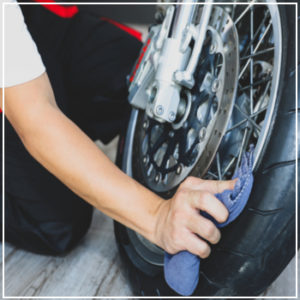
Whether it’s your car, truck or motorcycle, all vehicles need to be washed regularly. Debris and dirt can tarnish its appearance, while corrosive substances like road salt can cause metal parts to rust. As such, washing your motorcycle is an essential maintenance task.
Yet, a motorcycle cannot be taken through the car wash like a passenger vehicle, as its exposed components are too delicate for a high stream of water. Failing to wash or using high-pressure water could affect your bike’s structural and operational components.
To keep your motorcycle clean and ready for your next ride, get started with these 6 tips.
1. Have All Your Supplies
Along with water, it’s recommended you have multiple cleaning tools on-hand. Sponges are ideal for removing dirt without scratching paint, brushes are crucial for the fine components, and flannel or microfiber are gentle enough to dry off the bike. Also have a separate cloth for removing any debris on the vehicle before you finish with a detailing product.
At most dealerships, you can purchase specific cleaning and soap items that also help eliminate scratches. If you have an older bike with chains, you will need to apply a specific type of lubricant. Be sure to avoid the detergent you would use on your car and never use dish soap to wash a bike.
As the final step, you’ll need to replace the lube that was cleaned off, especially on the chain. Have some additional lube ready for application once the bike has fully dried.
2. Avoid These Techniques
As we mentioned above, high-pressure hoses are out of the question when washing your motorcycle. In addition to avoiding the car wash, don’t use a pressure washer on your bike, even on the lowest setting. Instead, carefully wash all parts with a bucket of water.
Washing should be avoided on hot days, when your motorcycle has been in direct sunlight, or if the engine is still hot. These factors can cause the soap to dry quicker and stick to the bike’s components, requiring you to work harder.
3. Preparing Your Motorcycle
Before using water and cleaner, it’s a good idea to check all electrical connections and cover or plug the exhaust pipe to prevent moisture from entering the exhaust system. If you have bags or other accessories attached to your vehicle, remove them for easier access to all the bike’s surfaces.
4. Cleaning Your Motorcycle
Starting with a hose on a low setting or a bucket of water, rinse off your bike, paying more attention to areas that gather more dirt, like the fenders and wheels.
Depending on the cleaner, you may need to simply spray it on the bike’s surface and rinse, or you may need to scrub it off with the sponge. So you’re not dragging dirt across your bike’s parts, regularly rinse the sponge or have a second bucket of only water. For the finer parts, you’ll want to use the brush.
To avoid washing the same parts repeatedly, begin at the top of the bike and work your way down, switching between the sponge and brush. At the same time, you have an opportunity to check for signs of wear and damage. Make any notes about parts that may need to be replaced in the near future.
Once you’ve gone over all surfaces, rinse off your bike again to remove any remaining dirt.
5. Drying and Lubricating
It’s never a good idea to apply lubrication and other detailing products to a damp bike. This can lock in moisture and trap dirt. Instead, use a fresh microfiber cloth to go over the bike’s surfaces. This process removes any residual water and remaining dirt particles.
Next, you’ll want to reapply the lube that was stripped off the chain after washing. If you’re looking to protect the paint and give your bike a new shine, apply a protective wax coating.
6. Sanitizing & Disinfecting
The Coronavirus pandemic has changed the way we approach cleaning and sanitation. Now more than ever, it’s important to thoroughly disinfect your bike after each ride, including all high-touch surfaces, and your gear, such as a helmet and gloves.
What’s your approach to cleaning your motorcycle? Share your tips on our Facebook page.
